
This blog post is going to be a step-by-step guide on how to perform a power audit so you can ACCURATELY size your camper solar system based on YOUR own power consumption to determine how many batteries you need for your camper van electrical system.
Also, we have interactive solar wiring diagrams that are
How to Size Your Camper Van Electrical System
You NEED to know how much power you use on a daily basis to determine the size of solar system you’ll need to power your camper.
Sure, you can buy a random solar kit and go for it, but more often than not, that tends to lead to disappointment in the performance of the system.
Be warned: This is an involved process. You’ll need to gather the items that you will be using (or look up their power usage) and put some numbers into the following spreadsheet you’ll need to download. After you’ve followed the step-by-step guide in this blog post, you’ll have a highly educated estimate of how much power you anticipate using throughout the day. This will give you a great baseline to determining how big of a camper solar setup you’ll need.
Step-by-Step Power Audit
What Appliances Will you be Powering?
You will need to gather as many of the items you will be powering. If you don’t physically have the items yet, you will need to look up their power consumption rates (or use the ones I have pre-filled in for you).
Not all Appliances are the Same
There are AC appliances, DC appliances, and DC components disguised as AC components. Confusing, I know. Hang with me, I’ll break it down.
AC Appliances
These are items that you plug into your normal household plug. These will be items like a Coffee Maker, Instant Pot, Blender, Induction Cooktop, and a Vitamix.
TAKE ACTION: Gather all of these items into one pile and put a sticky note with “Table 1.1” next to them.
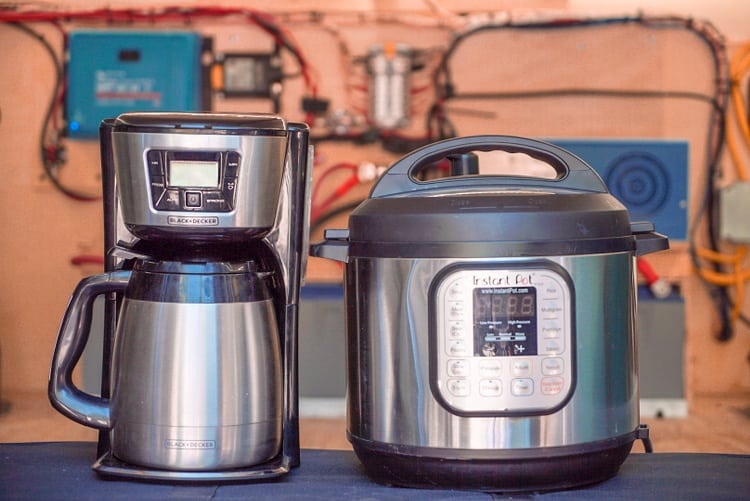
*But wait…there is a catch…*
DC Appliances disguised as AC Appliances
There are imposters in your ‘AC Appliances’ pile. There are likely items that plug into a normal household plug, that are actually DC appliances. These items are like Computers, video game consoles (
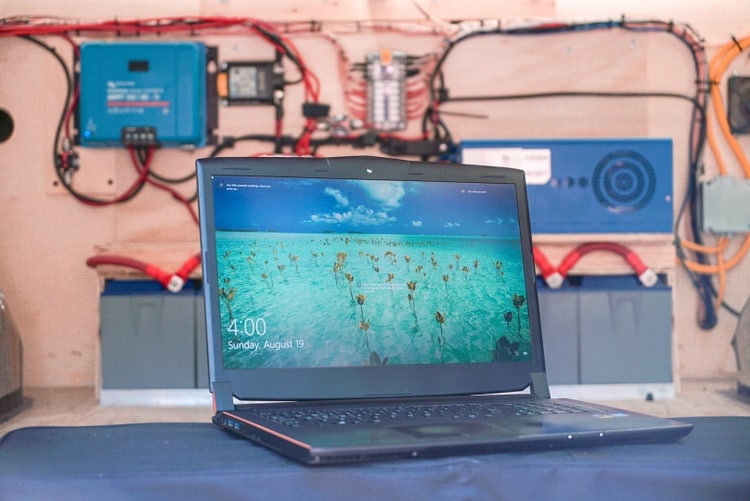
How to Identify these imposters: These items will have a ‘Wall Wart’ or an inline power supply AC/DC power adapter.
TAKE ACTION: Segregate these items into their own pile and label with a “Table 1.2” sticky note.
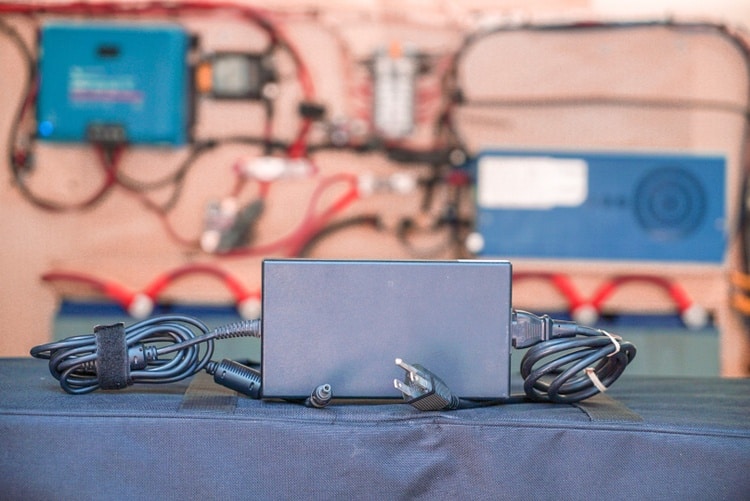
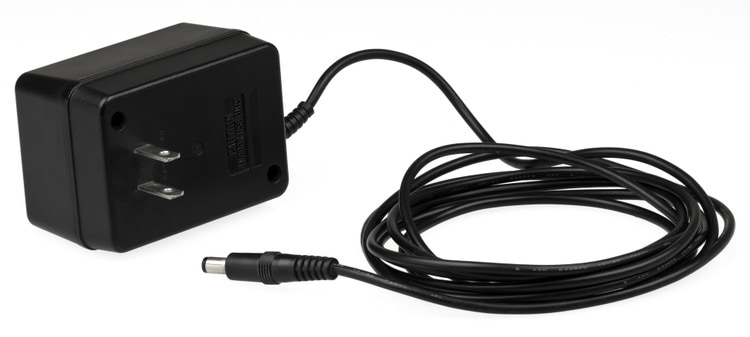
DC Appliances
These items will be wired directly to your DC Distribution block (Fuse Block). These will be items like 12v light strips, 12v puck lights, 12v fans, Maxxair Fans, Water Pump, and 12v TV
TAKE ACTION: All of these items get their own special pile. Label it with “Table 1.3”. “Table 1.3”.
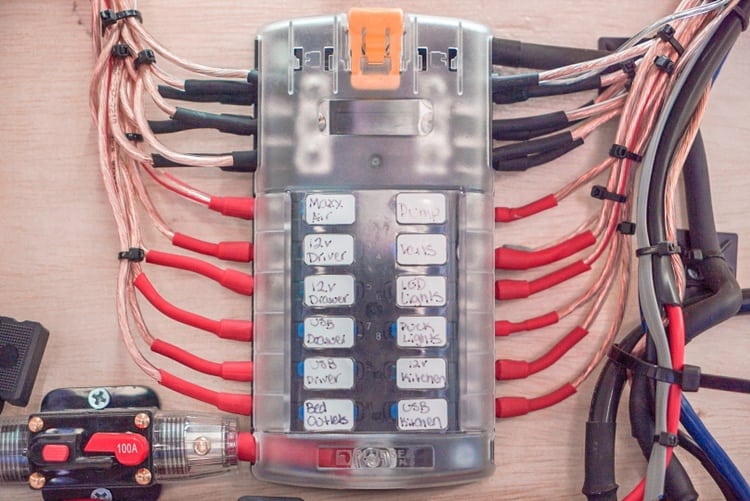
Single Charge Items
These will be items like Phones, Camera Batteries, Drone Batteries, External Charger Packs, Etc.. Basically, anything you charge up, then unplug to use.
TAKE ACTION: Put these items in a pile and sticky-note it “Table 1.4”
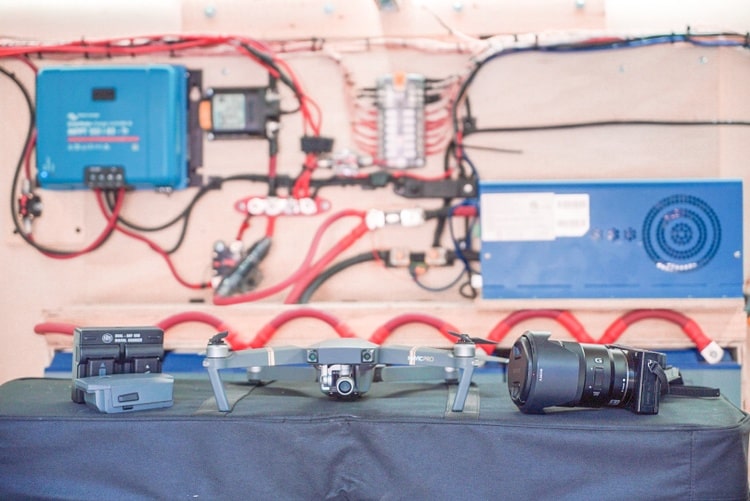
Full Day / Per Day use Items
These are items you will let run ‘all day’. 12v refrigerator that cycles off and on, Weboost 4g booster, hot water heater are a few examples.
*Note, The list is pre-populated with a few items for you to use as benchmarks, but if these items have already been accounted for in a previous table, there is no need to add them here.
*Note, The refrigerator listed in the pre-populated list is the ARB 65qt and most top loading 12v refrigerators will have similar electrical demands.
*Note, the hot water heater is a delicate calculation. The figure pre-input into the spreadsheet is for a 4 gallon Bosch hot water heater unit. It uses about 65 Amp hours to heat up, then it holds that heat for 12 hours-ish. The “Quantity” on that would be for “How many times do you plan on heating up 4 gallons of water”. Use this as a benchmark, but not a rule*
TAKE ACTION: These items go into yet another pile. Label it “Table 1.5”.
Performing a Step by Step Solar Power Audit
Now you have your 5 separate piles labeled with Tables 1.1 – 1.5, we are going to go through them, pile by pile, item by item and input the ACTUAL numbers to get you as close as you can get to a PROPER educated guess that will tell you how much solar power you will need based on how much power you use every day.
For all of these items you will need either watts and volts *OR* amps, *AND* a rough approximation of how many minutes per day you anticipate using the device.
Now, you’ll need the spreadsheet your downloaded earlier. (It was toward the top of this blog post)
Table 1.1 | 110v Appliances
Look for a plate on the device that tells you how many watts the appliance uses.
- Change the name of the Item as Necessary
- Input the Watts into column 2.
- Input the number of minutes you anticipate using the item per day.
Your spreadsheet has been pre-populated for popular appliances and power outputs. If your needs vary, alter as necessary by altering the GREEN columns. If you anticipate NOT using an item, you can delete the values in all of the GREEN columns, or simply input ‘0’ into the ‘Minutes Used Per Day’ Column.
Example:
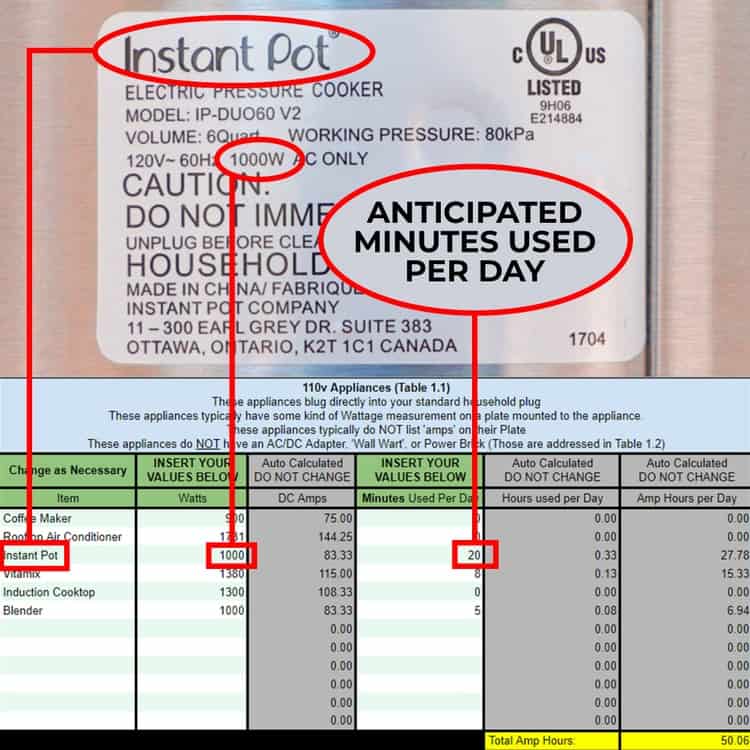
Table 1.2 | AC/DC Adapter Appliances
Look for a sticker on the wall wart or AC/DC Converter that tells you how many amps and volts the is on the Output side of the cord. It’ll look something like this:
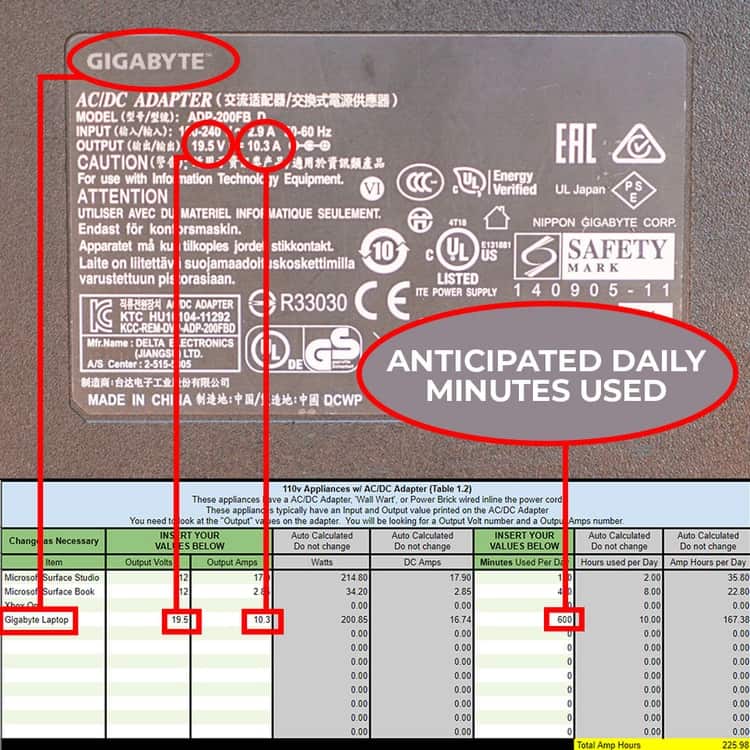
Your spreadsheet has been pre-populated for popular appliances and power outputs. If your needs vary, alter as necessary by altering the GREEN columns. If you anticipate NOT using an item, you can delete the values in all of the GREEN columns, or simply input ‘0’ into the ‘Minutes Used Per Day’ Column.
Table 1.3 | DC Appliances
DC powered appliances typically hide their power usage for some reason. If you look for a label or sticker with no success, usually looking online is the best option. You’ll be looking for the wattage of the device to insert it into column 2. If you find the amps and volts of the device instead, no worries! Table 1.3 has a
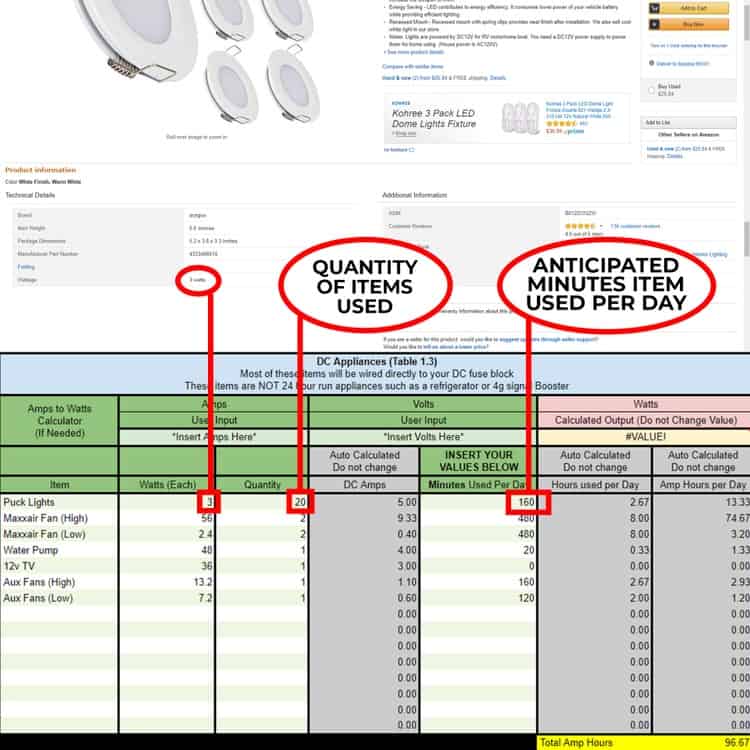
Your Spreadsheet has been pre-populated for popular appliances and power outputs. If your needs vary, alter as necessary by altering the GREEN columns. If you anticipate NOT using an item, you can delete the values in all of the GREEN columns, or simply input ‘0’ into the ‘Minutes Used Per Day’ Column.
Table 1.4 | Single Charge Items
For Table 1.4, you will:
- Change Column 1 to the Device Name.
- Change Column 2 to the Battery Size of the Device.
- Change Column 3 to the number of times you plan to charge the device per day.
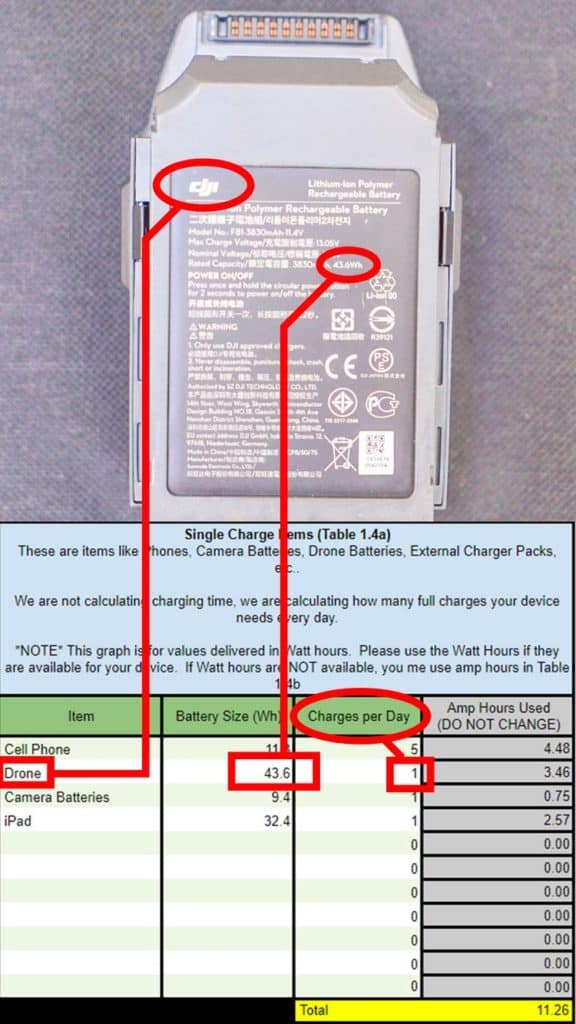
If given mAh (Milliamp Hours) input into Table 1.4b
Your Spreadsheet has been pre-populated for popular appliances and power outputs. If your needs vary, alter as necessary by altering the GREEN columns. If you anticipate NOT using an item, you can delete the values in all of the GREEN columns, or simply input ‘0’ into the ‘Minutes Used Per Day’ Column.
Table 1.5 | Full Day / Per Day Usage
Table 1.5 is for items that get used CONSTANTLY. You’ll have to take a constant measurement of your items over the course of 24 hours. This is good for things that cycle off and on like a refrigerator. The pre-populated ‘Refrigerator’ option is based on a top loading ARB 50qt 12v Refrigerator.
TOTAL: How Much Solar Power Do I need?
Now that you have filled in ALL the blanks with the electrical items you anticipate using throughout your normal day, check out ‘Table 1.6’. This is how many Amp Hours you will PERSONALLY consume per day according to all of your inputs as well as a recommendation for battery bank size, solar array size and a few other goodies:
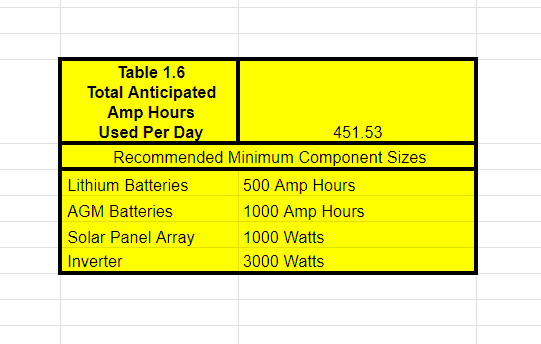
The numbers you see are just general recommendations. Want to spend more time in cloudy environments? Maybe you should consider sizing up a bit. Budget can’t handle your recommended components? Perhaps size down (but PLAN for expansion). These are all just general recommendations that I feel confident in recommending. Any more is better. Any less is on you.
Now that you know how much battery capacity you need in your camper van electrical system, now it’s time to decide if you want to play the short or long game and go with AGM batteries or Lithium Batteries. Check out our comparison here: https://www.explorist.life/choosing-a-solar-battery-bank-for-a-camper/
Everything that you are learning here is put to use in our FREE Interactive Solar Wiring Diagrams. If you haven’t yet, check them out as they are a complete solution for a camper van electrical system. Check them out here: https://www.explorist.life/solarwiringdiagrams/
Remember, this is just one part of a full camper van electrical educational series. To see all of the individual guides, click here: https://www.explorist.life/diy-campervan-solar
Finally, If you found this guide helpful, It’d truly mean the world to us if you’d share it with somebody who can use it, pin it to pinterest for later reference, or share it to a facebook group when somebody has a question about this subject. Click the bubble in the lower right corner to subscribe to be notified of future updates and as always, leave any questions you’ve got in the comments below.



82 Responses
What’s up Nate! Great guides, thank you so much for sharing them. I used your guides to confirm some early numbers and they were perfectly clear and simple to use.
Question about the new Battle Born BBGC3: can I run alternator charging with a single BBGC3 setup or will I still need multiple batteries to make that happen?
Thanks from Oregon!
They allow a charge of 135A per battery, so you should be good to go unless you are pushing some SERIOUS amperage.
Hi Nate, love the guides!
Appreciate the effort you’ve put into helping the van life community.
I’m using the audit spreadsheet for appliances in the UK where AC voltage is higher at 220-240v.
Does this affect your preloaded calculations considering you’re basing it off 110v?
All of the calculations will be the same. 🙂
Thanks of the Spreadsheet. very useful.
Everyone says that Watts are what is important, and easiest to work with.
Just wondering why your tables don’t calculate for Whrs required?
Watt-hours do make more sense, but amp hours are more common when talking about batteries.
Hi Nate, thank you so much for this super helpful spreadsheet 🙂 I was wondering if you could help me with a question regarding one of my AC/DC Adapter Appliances.
There’s 2 output volts and amps side by side:
5V 1.5A / 15V 2.6A.
Do you know which one I should input into the spreadsheet? Thank you!
Use the bigger one (15V 2.6A)
Not happy Useless excel spreadsheet doesn’t work on a phone can’t open tried copy pasteing it won’t add stuff together tried for ages waist of a night thanks heaps make a phone friendly version
This spreadsheet is designed in Google Sheets and is mobile friendly when using google sheets. Please use google sheets instead of excel if you wish for it to work properly.
@Nate Yarbrough, I just used your FREE spreadsheet and it worked very well. It confirmed my numbers and your tutorial is amazingly detailed and easy to follow. I am currently in the planning phase of my solar upgrade and actually reading most of your articles so I do not have to reinvent the wheel. Thank you, Thank you!!!
Great! Glad it helped.
Hi Nate. I designed my system on the wiring diagram I bought from you. Thank you for making it available. I have four 100AH Battle Born Batteries. Two had to be positioned in opposite direction of the other two. I know it’s ideal to have all cables the same length. Does it matter if two cables are shorter than the others? All cables are 4/0 gauge, shortest is 6”, longest is 24”.
The cables should indeed be as close to equal length as possible. Your system won’t burn down or anything with unequal cable lengths, but there may be some long term battery balancing issues (after 5 years or so).
Hey Nate,
So I built out a Dodge Promaster myself and took it on a trip across the country for a little over a month. When building the electrical system, I followed your electrical diagrams and they worked perfectly, so thank you so much for all the work you do on those!
I got back about two months ago and left my van in my garage. I thought I had turned the disconnect switch off, but I had not and now my AGMs are fully discharged and nothing is working (including my victron battery monitor). I am trying to figure out if I ruined my batteries and need new ones or if there is a way to save them and charge them back up. You were the only one I could think to ask, as I could not find any answers online. Any help would be greatly appreciated.
Thank you for your time,
Tucker Horsley
Was so excited to find your post, but quickly became overwhelmed! After entering data into your spreadsheet, here are my values…
Lithium Batteries 1200 Amp Hours
Solar Panel Array 2400 Watts
Inverter 3000 Watts
So, does that mean I buy 12 -100ah? Are there bigger batteries? And, I haven’t even started on the rest of the components! HELP!
If 1200 Amp Hours of usable power is needed for your electrical demands; you would, indeed, need 12x 100Ah batteries. I recommend using Battle Born batteries and they currently do not make a battery bigger than 100Ah. That’s a huge battery bank… What is your biggest load you are trying to power? If you have an air conditioner in the calculator, delete it and see how many amp hours it says then.
I’m in the same boat here. I’ve watched videos of off-grid systems that power a ductless mini split. I would really like to get one but the calculator is saying I will need so many panels and batteries. Is there something I’m missing? How do people accomplish having a mini split with the rest of their electronics?
Not calling anybody in-particular out, but there are a lot of people that are not truthful with the capabilities of their system. That’s all I’m going to say about that… Now… what I recommend for air conditioning… is to do the power audit WITHOUT including the air conditioner and see how many batteries you need. Size your battery bank up as your budget allows and plan to mount/carry a generator like a Honda EU2000 or similar for air conditioner usage. Although air conditioner usage is possible, it’s not particularly feasible.
Aw that’s disappointing. I’ve been putting off making my solar purchases because I can’t find consistent information on powering a system. That being said…Do you think people have been overall happy with just using two fans to create air circulation and just skip the a/c unit? I have a 15′ box truck I’m converting if that changes anything.
Hello
I build in 24V and then I wonder if I only subtract half the Amper amount on the battery bank or how does it work? Also builds in 220V so the whole living part will be 220V
Best Regards Martin
Yes, for a 24v system; divide your amp hours needed @12v by 2.
Hi Nate,
I am reading all your tutorials and I find them very very useful. For sure I will use your service to complete or validate my DIY RV electrical circuit.
For now, I have only three simple questions.
1- In your Power Audit Spreadsheet, I wonder why you put some 12VDC appliances in table 1.5.
Why those appliances are not put in table 1.3 ? I do not see the diffenrece or the usage of table 1.5.
2- For appliances w AC/DC adapter, for example; At home, I charge my Apple cell phone on a 110V outlet with a USB/110V adapter. In my RV, should I plug my cell phone in a 110VAC outlet or in A USB (12VDC) outlet?
3- For wattage/amperage calculations, for AC which voltage should we use 110VAC or 120VAC?
Thanks
1: Table 1.5 is more of a ‘per day’ calculation. For example… a hot water heater uses a TON of power when heating water; so if we were to say that the hot water heater ‘is being used’ for 24hrs per day; our values will be off because in all reality, the hot water heater cycles off and on throughout the day.
2: Ideally a USB (powered by 12v) outlet so you won’t have to draw that power through the inverter which would have additional efficiency losses.
3: 120V
I am not sure if this was just a spreedsheet error but the results from table 1.4b are not being added into table 1.6
I’ll check into it and make the adjustment. Thanks for the heads up!
I have a full line of Milwaukee battery tools. I am currently setting up a 6×12 enclosed trailer and I will need a solar setup with shore power interrupt. I will use very few 110 items, a small bandsaw, eventually a fridge, and microwave, of course a coffee maker, along with a bank of chargers for my Milwaukee tools. I don’t believe I will need more than a 200 amp setup. Any hints?
Sure! You should do the power audit as shown on this page. 🙂
Great Idiots guide,
thanks form the chief Idiot
Thanks Nate, Wish I had this when I first designed my system. it would have saved me a lot of time. I am doing a charger up grade and with a couple mods to your spread sheet it was easy to a few what ifs.
Greatly appreciate your effort and knowledge.
Thank you!!! I had pieces of this info all of the web and just didn’t know how to bring it all together. This spreadsheet is incredibly simple and useful. Can’t wait to put it to use!
When discount box stores started showing up and running conventional businesses out of town, a knowledgeable sales associate once said to me “People won’t save any money if they buy the wrong stuff.” I would like to add a big heartfelt thank you to Nate for providing this information to those of us just starting out. You have personally saved me from several costly mistakes, and the time lost to backtrack from them. And I am sure I am not alone. Cheers!!!
Hi Nate, thank you so much for all you do on this site! It is so helpful! I’m doing the energy audit but had a question about the overhead AC. If I get one, I anticipate using shore power only to power it. Can I just leave it off the energy audit or are there other considerations? Thank you!
Yes, that’s what I would recommend. If you aren’t planning on powering it from your batteries, just leave it off of the audit.
Hi Nate,
I have nailed our consumption at a modest enough 275 Ah. We already have a 100Ah leisure battery so the solar will need to be pumping twice that or more each day to keep up. You recommendation seems to be for about 650 lead acid or 350 Ah Lithium.
My question is where could I find the space for even 350Ah Lithiums never mind the lead acid pack?
Our MH is a Swift Ducato Escape 624, not large but just fine for we two.
Hey John! I’m not sure where you’d put the batteries as I do not know how your camper is set up. That’ll be up to you to determine where you have space for them.
Hi Nate, This is fantastic, I have been struggling with this for so long. Thanks very much for the time you have put into this and sharing with us.
Hi Nate, great compliments on the best tutorial I’ve ever seen. With regard to LiFePo4 Batteries I understood that they are very temperature sensitive. Would it work to use a temp controller to monitor the bat temperature and to switch off loading once the temp is going beyond e.g. 5 degrees Celsius? Or are these bats also (unrecoverable) damaged when just exposed to low temperatures ?
Hey Juerg! Check this out: https://www.youtube.com/watch?v=USOWVAeb1H8
Good Morning Nate,
So, i’m trying to future proof my build, allowing me to add additional panels and also additional batteries to the battery bank after my initial build.
I was thinking starting off with 2x 160w 12v renogy panels on the roof and one battleborn 100ah lithium.
Down the road, i would add 2x more of the solar panels, and incrementally add the batteries as i get paid. I know more panels means a faster charge with the battery bank, my concern is the electrical side, is it as simple as adding an addition battery and rewiring the battery bank to accommodate the new batteries or is there more to it?
I can’t seem to find the answer in all of my google searches. I’m hoping you would know a place to find it, if you don’t know the answer.
Plan the build around the biggest that you plan on making it and simply add as you described. There’s no harm in that. The only issue will be with charging via the alternator. Hold off on charging via the alternator until you get 2 batteries in the system.
Why can you not charge with the alt with one battery?
Depending on the method of battery charging, one battery may not be able to accept high amperage charging form the alternator (like we would see with a battery isolator). If using a Battery to Battery charger, it would be fine (depending on the individual components, of course).
Hi there, I am an older norwegian with a young hart living in Mexico, old but new to all this exiting information, dont know if you can helpme out but its worth a try.
I use oxygen part of the day, Inogen one G3 and want to charge the lithium battery via solar panels and a deep cycle battery, I am looking at a Renergy panel with a Renergy Wanderer controller but I am barely in the beginning of planning my G3 beeing the main problem to solve first.
I would be happy to hear your point of vieww
I recommend you perform a power audit to determine how much power you can anticipate using throughout the day. Step by Step directions are found on this post: https://www.explorist.life/what-size-of-solar-system-is-needed-to-power-a-camper/
Four panels 400 wats it’s ok with an inverter/charger 2000 watts I only have one tv ,domestic fridge,lights..that’s it.
Once you finish your solar audit from the instruction provided on this page, recommendations for panels and inverter are made at the bottom of the spreadsheet.
Hey Nate… What a site!!! I’ve learned a ton and feel confident I could plan and execute a complete build off everything you’ve provided, and I have zero experience in this area.
Question, for a 120v 3.1cu fridge that I run all day what would you rate the amp hours at per day (conservative # is great)
Also after inputting all my electrical usage in it came back at under 400ah and my heaviest draw on 110v is from a 1700w item and the spreadsheet still recommends a 3000w inverter… in another part of your blog you recommended using an inverter that exceeds your heaviest drawing daily use item, so would a 2000w inv be enough?
Thanks a ton
If you want to test the daily usage of your particular refrigerator you need to hook it up to a kill-a-watt meter (https://amzn.to/2KhNBHj) so you can get a real measurement.
For the inverter: I do build in a bit of buffer. It’s up to you if you want to size down keep the margin.
Well done. It seem that your calculator has a minimum of 200 Watts of solar and 100 AH of battery. I did my calculations and I will be using under 25 Amp Hrs per day. Can I get away with 100 watts in solar and an 80 AH AGM sealed battery?
IMO, you’re in the realm of simply using a Goal Zero unit. It’ll be more cost effective as such a small system.
Hi Nate,
I love your work. The page on wiring solar panels as Series or Parallel is stellar. I’ve never seen anyone make the case for Series to maximize battery charging for less that ideal sun input (not in your control). Awesome.
Anyway, regarding the spreadsheet above. I have the Wh and mAh data for my iPhone and iPad. I plugged both into Tables 1.4a and 1.4b as a test and got different results. You need a voltage to make the unit conversion from Wh to mAh – wouldn’t that voltage be different for each device based on the output of the device?
Keep up the good work,
Dave
Good catch! Yes, that’s correct. I’ll check it out and adjust it soon. Currently, as it sits, it should be FAIRLY close though.
Ran the Calculator says i need 100ah worth of batteries but the spreadsheet doesn’t seem to factor current draw. If i have an appliance that wants to run at 1500 watts AC for 10 minutes that seems to exceed the maximum draw from the Battle Born Batteries right? that would be 150amp DC. So i would need (2) 50AH batteries right? except the 50ah batteries seem to only allow 60Amps continuous so does that mean i’d need 3 batteries?
That’s a good point and you are correct that the calculator doesn’t take that into account. I’ll put that on the schedule to add that feature. In the meantime, you’ll really be looking at 2x100Ah Battle Born Batteries as each battery has a continuous discharge rating of 100 Amps, so 2 x 100Ah Batteries would double that to a continuous discharge rate of 200 Amps.
Hey Nate !
Great tutorial ! Just wondering why do we dimensions our battery to be able to store one day of power ? Why don’t we just need to have batteries that can store the energy needed for the night and the less sunny part of the day ? I know it is to be sure not to run out of power but isn’t it a bit overkill?
“Overkill” is a subjective term. 🙂
Hi Nate, I’m hoping to use a Bosch electric tank-less water heater in our camper-van build and was wondering, wouldn’t the minutes used per day be only when I turn on a hot water tap? Like taking a shower or washing dishes, and if so it would only be about 30-40 minutes per day.
The figures in the spreadsheet are based on a few people who have, and use the unit and what their real life energy usage is for the unit. If you’d rather do your own calculations for what you think you’ll use, just put a zero next to the water heater (or erase it), and follow the steps in the 110v section and add the heater to your calculations that way.
This is incredible. And for free?! Will definitely be buying from your affiliate links. Thank you for all the time and thought you’ve put into this! You have a knack for breaking things down and explaining it in a way that makes sense (and making lovely spreadsheets and diagrams). Just wanted to say thanks!
Awesome! Glad you found it helpful. 🙂 🙂
I love this! I am currently chomping away at getting all the values needed for the spreadsheet. I am finding though that in Excel 2016, the AGM Battery field gives an error. Can I assume that the AGM requirement is twice the Lithium requirement and use the formula =(ROUNDUP(F87,-2)*2)&” Amp Hours”? Thank you very much for putting this together. I was aiming much higher than I thought. This is helping me realistically plan my trailer conversion. Wish me luck. Happy trails.
Awesome! Glad it’s helping!
Yeah, the spreadsheet does some weird stuff when it’s imported into Excel rather than using it natively in Google Sheets, but yes, The AGM figure should be, basically, lithium x2.
Nate,
This is incredible!!! Are you an electrical engineer or contractor by trade? This has been the best breakdown and explanation I have come across in allot of research. I am brand new to full time RV’ing and want to add a solar system to my Bigfoot travel trailer.
Thank you so much for all the time and effort you put into this!!
Shane
Hey Shane! Glad it’s helpful!
My degree is in Fire Science, so nope… not any of that stuff by trade. lol
I only need power to run a maxxair fan overnight which came out to about 93 ah. If I get a 100 ah battery, wouldn’t that discharge it almost completely? Would that harm the battery? Also the recommendation stated 200w solar panel. Is it possible to go less, like just one 100w or something?
A maxxair fan only uses somewhere in the 4 amp ballpark; so overnight (say, 10 hours) it would only use 40 amp hours. You can always go with fewer solar panels, but I do make those recommendations for a very specific reason: https://www.explorist.life/how-many-solar-panels-are-needed-to-power-a-camper/
This is amazing.
I am in Europe (240V). How can I convert your genius spreadsheet to work for my calculations?
Would you do a favor for me? See the items I labled table 1.2? Like the computer and ‘wall wart’ items? Would you take a picture of the back of all of the numbers on the back of that adapter and send it to me? That would help me out a ton.
Hi Nate, awesome tutorial! I am also in the EU and I was wonder how to modify your spreadsheet, thank you!
Hey Salva! I will be adding a EU version in the near future. I’ll announce it to our newsletter when it goes live or you can just keep an eye on it.
Howdy – Any news on the EU spread sheet? I notice all your DC Amps are divisible by 12 and your Watts are Output volts multiplied by output Amps.
Do you know what the calculations would need to be for 240v appliances?
It shouldn’t matter. 🙂
Hi Nate,
Really appreciate you putting all this info up! If i am to go ham with 600ah of lithium will i run into any issues with an array maxing at about 700 watts? I’m also planning to charge via alternator. Is bigger always better when it comes to battery banks or am i going to run into unforeseen issues?
The main issue is that if you drained your 600Ah battery bank, 700w of solar would likely not charge it back up the next day. Depending on your energy needs, I’d recommend planning to have a generator for backup.
Stefan – I don’t think it makes a difference. Just put in the values for your 240v gear into the 110v tables, you’re only putting in watts and time used after all. I can’t see anything in the formulae that would make a difference.
Agreed. 🙂
Hey Nate,
Really appreciate the spreadsheet has been a huge help… Agreed in your sheet it doesn’t seems to make a difference, however I am thrown off by C14:C15 calcualtion.. where by you dive by by 12V and not 110V in your case (240) for me… Is this becasue you are working out Amp Hour which should be equivalent whether put through 100V or 240V? Thanks again!
Lawrence
Good question! It has to be 12v because even though your are USING the power at 110v or 240v, the power is originating from the battery bank which is 12v. Since we are trying to find the amp hours used from the battery bank; we must use the battery bank voltage in that case.
Thanks so much. Just getting started on a new Transit Connect build. Will use solar and inverter generator combination because I will have some air conditioning usage. Lithium batteries are planned. Trying to figure out how to size the inverter/charge controller for charging with the generator. Any help is appreciated
I would do the power audit, but leave the air conditioner out of the power audit. Once you get your final recommended numbers, I’d advise rounding up as necessary. Let me know what kind of numbers you come up with and I’ll make another suggestion.